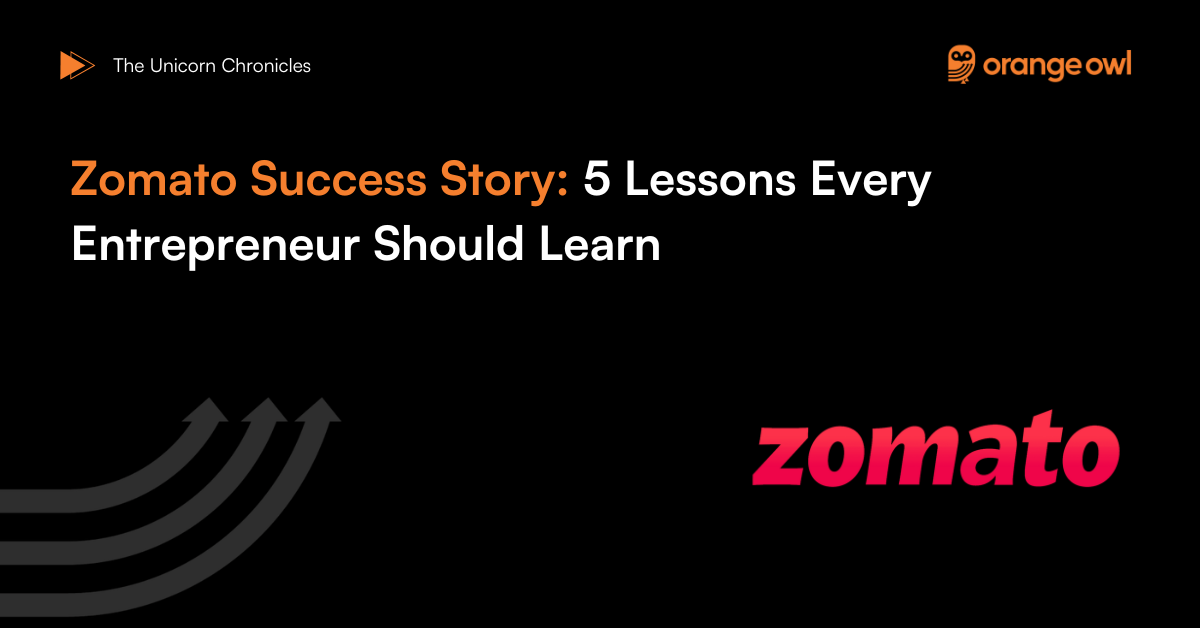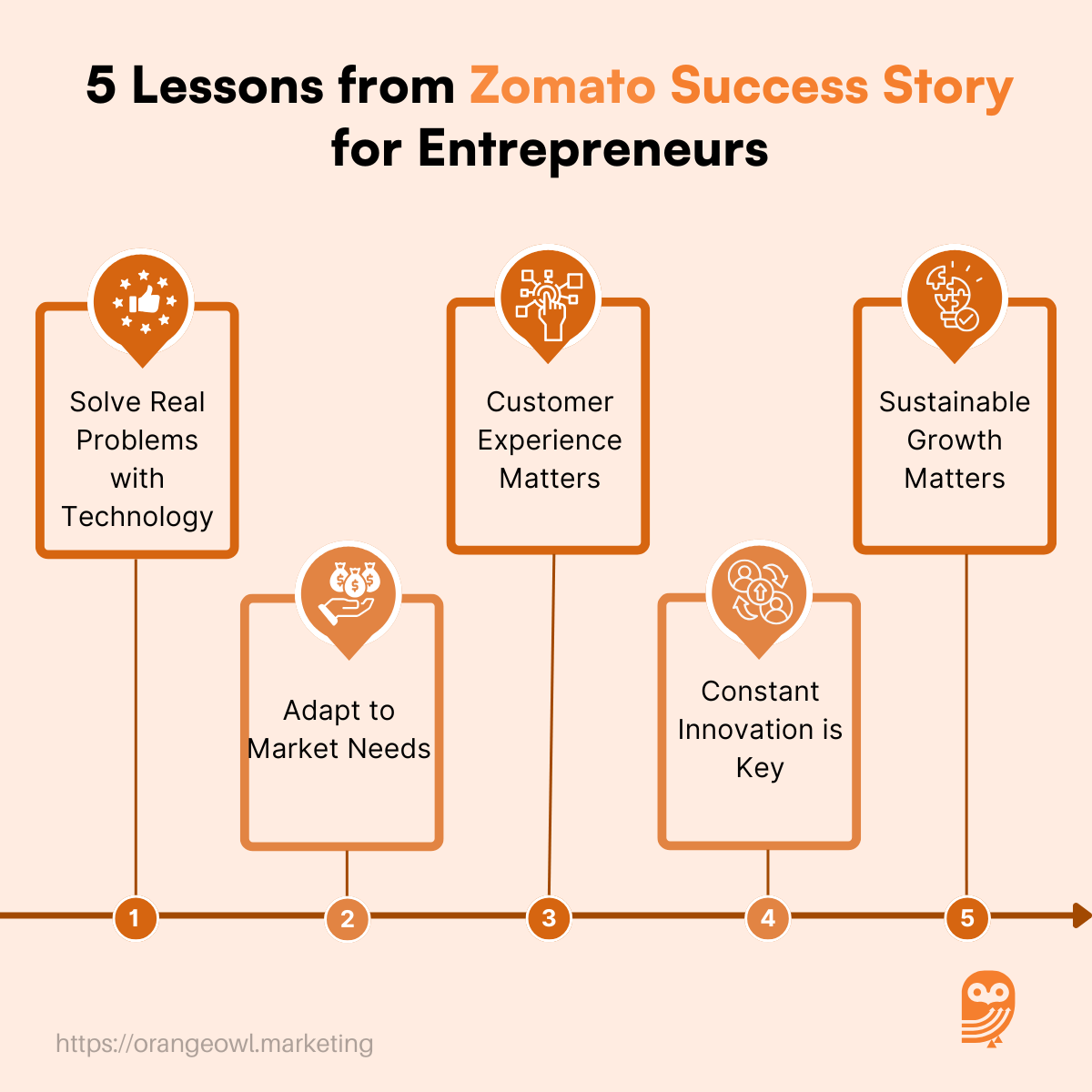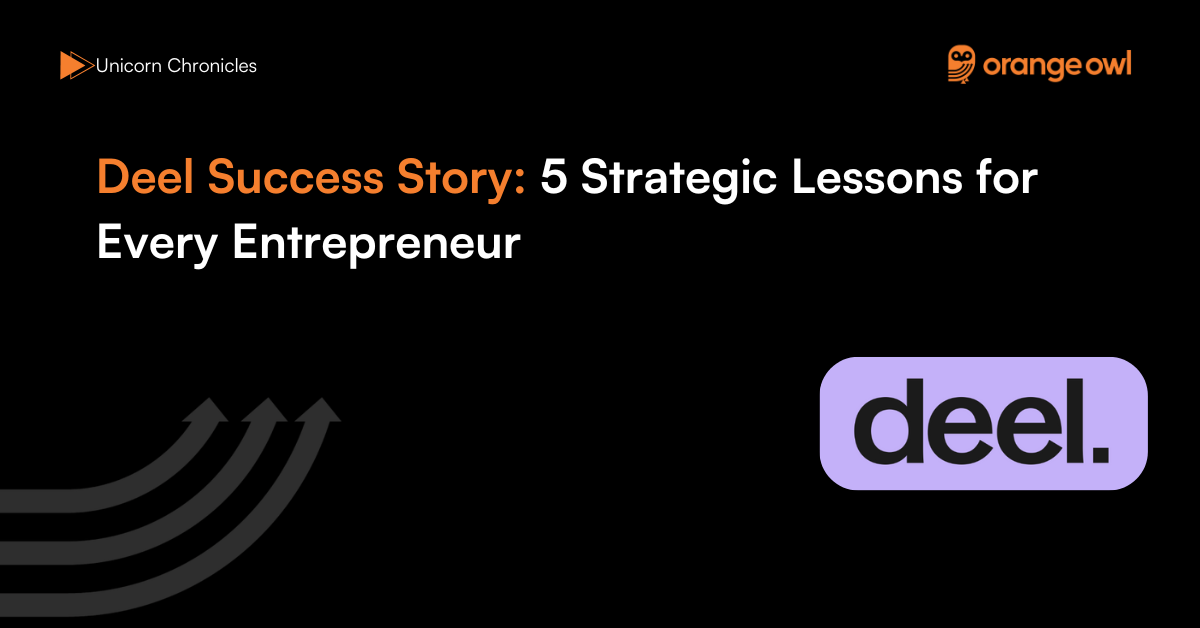Zomato Success Story: 5 Lessons Every Entrepreneur Should Learn
Vivek Goel
June 17, 2025

Table of Contents
Introduction
Zomato, one of the most successful unicorns to emerge from India, has fundamentally changed how we eat, discover restaurants, and order food. What started as a small idea by two IIT Delhi graduates in 2008 has evolved into a global food-tech giant, with a valuation of over $13 billion.
Deepinder Goyal, co-founder of Zomato, believes that “innovation is the key to success,” and this relentless drive to innovate has propelled Zomato’s journey. As highlighted in a recent podcast interview, he attributes their success to constant reinvention and an obsession with customer experience.
Zomato’s journey is full of challenges, innovation, and strategic decisions that shaped it into the unicorn we know today. Through this blog, we will explore Zomato’s origin, its challenges, growth strategies, and marketing efforts. Most importantly, we will delve into five crucial entrepreneurial lessons that every aspiring entrepreneur can learn from Zomato’s success story.
Origin Story
Why Was Zomato Started?
Zomato’s origin story is quite simple yet profound. Deepinder Goyal and Pankaj Chaddah, both IIT Delhi alumni, observed a significant gap in the Indian market for a centralized, digital platform for restaurant discovery.
Before Zomato, people relied on word of mouth, newspapers, or outdated brochures for restaurant information. Deepinder and Pankaj believed that technology could bridge this gap.
With this belief in mind, they created Foodiebay in 2008, which later became Zomato, as an online platform to provide restaurant reviews, menus, and ratings.
“We built Zomato with the simple goal of providing people with the information they needed to make informed dining decisions.” – Deepinder Goyal
According to the podcast, the initial traction came from simple word-of-mouth marketing within office spaces, proving that product-market fit doesn’t always require massive marketing budgets at the outset.
The Founders and Their Vision
Deepinder Goyal and Pankaj Chaddah had different yet complementary skill sets that played a crucial role in shaping Zomato’s foundation.
Deepinder, with his background in Mechanical Engineering from IIT Delhi, possessed strong analytical thinking, problem-solving abilities, and operational expertise, which helped in structuring the business model and optimizing the platform’s efficiency.
On the other hand, Pankaj Chaddah, who had a deep understanding of computer science and technology, brought the technical acumen required to build a seamless, scalable, and user-friendly platform.
Together, they leveraged their unique strengths—Deepinder’s ability to identify business opportunities and drive execution, and Pankaj’s technical prowess in designing the product—to create a disruptive digital solution for restaurant discovery and food delivery.
Their shared passion for technology and problem-solving, combined with their willingness to take risks and challenge the traditional ways of the restaurant industry, allowed them to address a major gap in the dining experience in India.
By fusing business intelligence, data-driven insights, and customer-centric innovation, they built Zomato into what it is today—a leading global food-tech platform that transformed the way people discover, order, and experience food.
Their vision for Zomato was simple:
“To make dining out an enjoyable, informed experience.”
Business Space and Early Challenges
Industry Overview
At the time Zomato was launched, the food-tech industry in India was still in its early stages, with very few players experimenting with online restaurant discovery and food delivery. The idea of accessing restaurant menus, reviews, and ratings through a digital platform was relatively new and unfamiliar to both consumers and businesses.
People were accustomed to relying on word-of-mouth recommendations, printed menus, or physically visiting restaurants to make their dining choices. For restaurant owners, the primary focus was on walk-in customers and traditional marketing methods, with little inclination towards adopting technology-driven solutions.
Many businesses were hesitant about investing time and resources into online platforms, as they were uncertain about the impact on their customer base and revenue. Unlike today’s digital-first approach, the restaurant industry back then was largely offline and dependent on conventional operations.
One of Zomato’s biggest hurdles was changing consumer behaviour and convincing restaurant owners of the platform’s potential benefits. Many restaurant owners were sceptical about listing their menus online and engaging with customers digitally, fearing that it might not result in tangible business growth.
Zomato had to educate both customers and businesses on the advantages of a centralized restaurant discovery platform. Through persistent innovation, strategic partnerships, and customer engagement, Zomato gradually reshaped the industry, making online restaurant discovery and food delivery a mainstream part of urban life in India.
Challenges in the Industry
One of the major hurdles Zomato faced in its early days was convincing restaurant owners to pay for listings on the platform. At a time when digital marketing was not widely adopted in the restaurant industry, many business owners were skeptical about the value of an online presence.
They relied heavily on traditional advertising methods such as newspaper ads, flyers, and word-of-mouth recommendations.
In a podcast interview, Deepinder Goyal recalled how difficult it was to persuade restaurant owners that being listed on Zomato could drive more footfall and online orders. Many restaurateurs questioned why they needed to pay for visibility on a digital platform when they were already attracting customers through conventional means.
Additionally, there was uncertainty about the return on investment (ROI), as the concept of digital restaurant discovery was still new.
To overcome this challenge, Zomato had to demonstrate tangible benefits, such as increased visibility, higher customer engagement, and improved brand recognition.
Over time, as Zomato continued to prove its effectiveness through data-driven insights and customer reviews, more restaurants began to recognize the potential of digital marketing and willingly partnered with the platform.
“Convincing restaurant owners was difficult because most of them didn’t initially see the need for a platform like Zomato.”
Early Struggles
From funding challenges to technical hurdles, Zomato faced its fair share of struggles in the early days. The podcast revealed an interesting insight—initial funding was not easy to secure because the concept of food-tech was still evolving in India. Zomato had to bootstrap for a long time before investors saw its potential.
“Scaling in a country like India with diverse infrastructure challenges was never easy.”
Growth Strategies
General Growth Strategies
Zomato’s growth strategy revolved around continuous innovation and a diversified revenue model, ensuring that the company stayed ahead in the competitive food-tech industry.
Initially starting as a restaurant discovery platform, Zomato quickly expanded into online food delivery, tapping into the growing demand for convenience.
To further enhance customer engagement and revenue streams, it introduced subscription services like Zomato Gold and Pro, offering exclusive discounts and loyalty benefits.
Additionally, Zomato ventured into cloud kitchens, enabling restaurants to operate delivery-only outlets without the overhead costs of traditional dine-in spaces. This multi-faceted approach allowed Zomato to scale rapidly while maintaining its dominance in the food-tech ecosystem.
Unique Strategic Moves
A key strategic move was Zomato’s expansion into international markets through acquisitions. The company acquired MenuPages, UrbanSpoon, and other players to establish its presence abroad.
Additionally, Zomato’s focus on hyper-localization played a crucial role in its success. Deepinder revealed that the team focused on understanding regional eating habits and tailoring services accordingly.
“One size does not fit all in the food business. Customization is key.”
Marketing Strategies
Traditional vs. Innovative Approaches
Zomato revolutionized traditional marketing strategies by leveraging humour-driven, relatable content that resonated with a wide audience. Instead of relying solely on conventional advertising, the brand crafted quirky social media posts, witty push notifications, and trend-based campaigns that quickly went viral.
Zomato’s ability to create shareable, meme-worthy content played a crucial role in establishing a strong brand identity. Through creative digital storytelling and engaging visuals, Zomato built an emotional connection with users, making it more than just a food delivery service. This bold, unconventional marketing approach helped the brand stand out in a crowded industry and drive organic growth.
Specific Campaigns and Channels
Zomato’s quirky push notifications and witty Twitter campaigns have become a hallmark of its marketing strategy, setting it apart from competitors. The brand mastered the art of using humour, pop culture references, and timely trends to engage with its audience in an authentic way.
Deepinder Goyal emphasized that their marketing approach was highly data-driven, continuously analyzing engagement metrics, user interactions, and campaign performance to optimize content. By understanding what resonates with customers, Zomato was able to refine its messaging and enhance brand recall. This strategic mix of creativity and analytics helped Zomato build a strong, relatable, and memorable brand presence.
Content and Branding
“Content-led growth is at the core of Zomato’s strategy.”
Zomato effectively leveraged memes, cultural references, and witty advertisements to create a fun and engaging brand personality. By tapping into trending topics, internet humour, and everyday experiences, the company made its marketing highly relatable to its audience.
This unique and consistent brand voice helped Zomato stand out from competitors in the crowded food-tech space. The company’s ability to blend creativity with relevance ensured that its campaigns resonated with users and encouraged organic sharing. As a result, Zomato not only boosted customer engagement but also strengthened its brand loyalty and recall.
5 Lessons Every Entrepreneur Should Learn from Zomato
1. Solve Real Problems with Technology
One of the fundamental reasons behind Zomato’s success is its ability to address real-world pain points using technology. Before Zomato, people relied on outdated brochures, word-of-mouth recommendations, or limited newspaper listings to discover restaurants. The founders recognized this gap and built a platform that provided accurate, updated restaurant information, user reviews, and ratings—all in one place.
As technology advanced, Zomato continued to evolve. It integrated real-time restaurant availability, digital menus, AI-driven food recommendations, and an efficient delivery network. The key takeaway for entrepreneurs is that innovation must be driven by genuine consumer needs. Businesses that solve real problems naturally attract users and create long-term value.
🔹 Entrepreneurial Insight
Before starting a business, identify an existing inefficiency or problem and leverage technology to solve it in a scalable way.
2. Adapt to Market Needs
Zomato did not remain a static platform. Over time, it adapted its business model based on changing customer preferences and market dynamics. Initially, it was just a restaurant discovery and review platform, but as food delivery gained traction, Zomato expanded into that space to stay relevant. Later, it introduced cloud kitchens to help restaurants scale without investing in physical locations.
Additionally, Zomato Pro (formerly Zomato Gold) was introduced as a premium subscription service to enhance customer loyalty. This ability to pivot and evolve with market trends ensured that Zomato remained at the forefront of the food-tech industry.
🔹 Entrepreneurial Insight:
Businesses that fail to adapt risk becoming obsolete. Entrepreneurs should continuously analyze consumer behavior, market trends, and emerging technologies to refine their offerings.

3. Customer Experience Matters
Zomato’s focus on user experience has been instrumental in its growth. The platform is designed to be intuitive, visually appealing, and easy to navigate. Features like personalized recommendations, real-time tracking, and a seamless ordering process have enhanced user engagement and retention.
Customer service also plays a huge role. Zomato has invested heavily in support teams, AI-driven chatbots, and quick issue resolution to ensure that both customers and restaurant partners have a smooth experience. This commitment to customer satisfaction has built trust and brand loyalty over time.
🔹 Entrepreneurial Insight:
A product’s usability and overall customer experience are just as important as the core service. Entrepreneurs should prioritize making their offerings intuitive, reliable, and responsive to customer needs.
4. Constant Innovation is Key
Zomato has always stayed ahead of the competition by continuously innovating. Some of its most impactful innovations include:
- Cloud Kitchens: Enabling restaurants to operate virtual kitchens without a traditional dine-in setup, reducing costs and increasing scalability.
- AI-Powered Recommendations: Using artificial intelligence to suggest restaurants based on user preferences and past behavior.
- Hyper-Local Strategy: Understanding regional consumer behavior and tailoring marketing efforts to specific locations.
- Zomato Pro & Dining Out Features: Creating premium membership models that offer discounts and exclusive perks to increase customer retention.
Innovation extends beyond technology—it also includes business models, marketing strategies, and partnerships. By constantly experimenting and iterating, Zomato has stayed relevant in a competitive landscape.
🔹 Entrepreneurial Insight:
Businesses that don’t innovate get left behind. Entrepreneurs should foster a culture of experimentation and continuous improvement to stay ahead.
5. Sustainable Growth Matters
Unlike some competitors that prioritized aggressive expansion at the cost of profitability, Zomato focused on sustainable growth. While it did expand globally, it also made strategic exits from underperforming markets, such as the U.S., to concentrate on core revenue-generating regions.
Additionally, Zomato has worked toward improving its unit economics by optimizing delivery costs, enhancing operational efficiency, and focusing on high-margin services like Zomato Pro and advertising. The company’s measured approach has helped it remain competitive while ensuring long-term financial health.
🔹 Entrepreneurial Insight:
Growth is important, but it must be sustainable. Startups should balance expansion with financial prudence to avoid burning through resources without a clear path to profitability.
Conclusion: Key Takeaways from Zomato’s Journey
Zomato’s success highlights the power of vision, resilience, and innovation in building a global brand. The company revolutionized food-tech by solving real problems, adapting to market needs, and prioritizing customer experience. Its journey underscores the importance of continuous learning, innovation, and sustainable growth for entrepreneurs.
Looking ahead, Zomato aims to leverage AI and automation for hyper-personalized experiences while focusing on sustainability through eco-friendly practices. As Deepinder Goyal puts it, “The future of food-tech will be about more personalization and more convenience.”
For entrepreneurs, Zomato’s story is a reminder that passion, adaptability, and customer obsession can turn a simple idea into a global phenomenon. The key takeaway? Never stop learning, never stop innovating.


